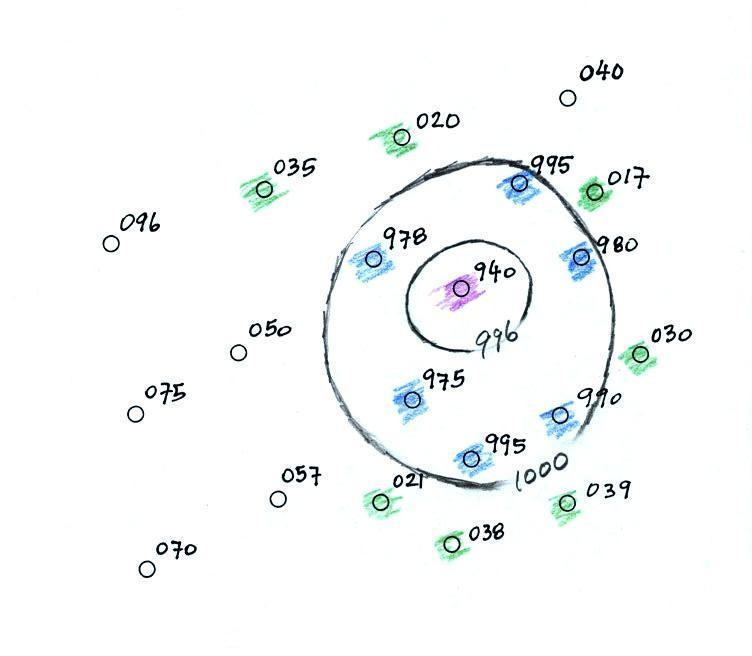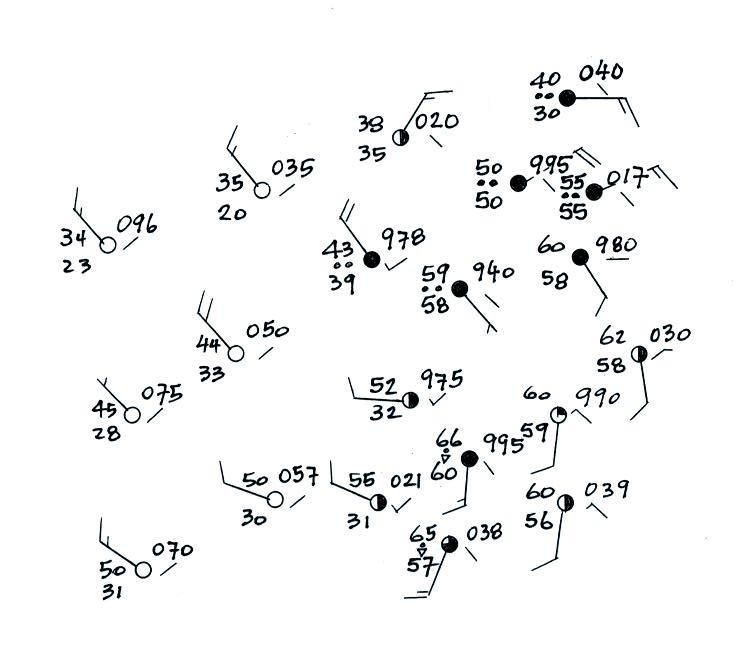Surface
Weather Map Analysis
Click here to download a map and instructions
for this exercise.
Study the weather map analysis example below before trying to do
the analysis.
Surface Weather Map Analysis
Example
We'll use the map and data below to illustrate the analysis
procedure.
Our first job will be to draw in some isobars. To make that job
easier the map has been redrawn below with just the pressure data shown.
Remember you must add either a 9 or a 10 in front of the data plotted
on the map. You must also add a decimal point. The highest
pressure value on the map is 1009.6 mb, the lowest is 994.0
mb. Isobars are normally drawn at 4 mb increments beginning with
a base value of 1000 mb. Four allowed isobar values (the red
values below) fall between the two extremes on the map:
994.0 mb 996
1000 1004 1008
1009.6
mb
Isobars will pass through any station with a value
that is exactly equal to the isobar's value. Otherwise isobars
pass between pairs of stations: one with a pressure greater the other
with a pressure smaller than the isobar's value.
On the map below stations with a pressure less than 996 mb have been
shaded purple. Stations with pressures between 996 mb and 1000 mb
have been shaded blue. The 996 mb isobar will separate the purple
stations from the blue stations. Stations with pressures between
1000 mb and 1004 mb have been colored green. The 1000 mb isobar
will separate the blue from the green stations.

Next we color stations with pressure between 1004 and 1008
yellow. The 1004 mb isobar will separate the yellow and green
shaded stations. Note there is one station in the upper right
corner with a pressure of exactly 1004.0 mb, the 1004 mb isobar will
pass through that station.
One station with a pressure greater than 1008 mb has been colored
orange. The 1008 mb isobar will separate this station from the
other stations on the map.
The isobaric analysis is now complete. We transfer these isobars
onto the complete weather map below. This allows us to
locate a surface center of low pressure.
Also on this map an attempt has been made to identify air masses with
different temperatures. The warmest air with temperatures in the
mid and lower 60s has been circled in orange.
In the next figure we will locate the cold front at the western
boundary of this warm air where cold air is pushing down from the
northwest. We will locate the warm front at the northern edge of
the warm air mass.
You should verify that some of the other criteria used to locate
fronts (changes in wind direction, changes in moisture content, clouds
and precipitation, pressure tendency) confirm these frontal
locations. Note that the warm and cold fronts both originate in
the center of low pressure. With time these fronts would rotate
in a counterclockwise direction around the low pressure center.
At the same time the low pressure center would most likely be moving to
the east or northeast.






